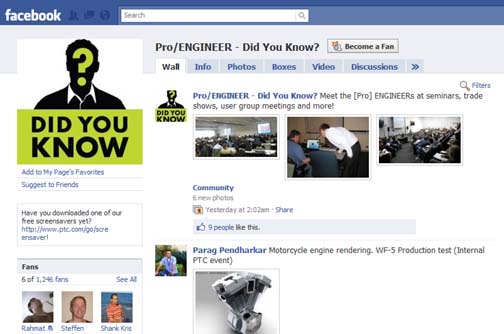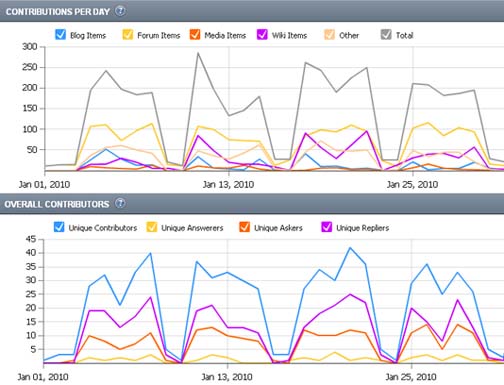Latest News
February 25, 2010
By Kenneth Wong
Can’t get a hold of someone on email or cellphone? You might have better luck reaching the elusive party via Facebook or Twitter. Have a question about creating circular patterns in a sheet metal part in Pro/E or lofting Polylines in AutoCAD? Post your question to Pro/ENGINEER – Did You Know? community page or AutoCAD Exchange fan page on Facebook. You might get your answer before a support person gets around to you.
With social networks swiftly replacing online forums and group emails, professional networking portals appropriated many of the characteristics found on Facebook, YouTube, and MySpace. Embedded videos, photo galleries, personal profiles, and blog posts are now ubiquitous elements.
Some of them offer useful, practical tips (tutorials, for example). Others let you help shape the next release of your favorite software. But in most cases, they simply serve as virtual places where people trade war stories, exchange jokes, and feel a sense of belonging. They may not let you render faster or make your simulation easier, but they’re a critical part of your personal and professional lifecycles, perhaps even your product lifecycle.
Social Engineering
Last year, betting on what it calls “social product development,” PTC expanded its outreach efforts to include blogs, Twitter, and Facebook. The company believes the same communication protocols found in social networks may hold the key to developing successful products and brands. With this vision, it launched Windchill ProductPoint, a web 2.0-inspired collaboration platform built on top of Microsoft SharePoint.
At the same time, the company went on a search for a director of social media. His duties, according to the job description found on several job search sites, include “use of social media as a communications channel with customers, partners and press … maintaining relationships with industry bloggers and internal company contacts, and improving PTC’s current marketing material through video, photos, and other multimedia.” The vacancy was recently filled by Alan Belniak, who maintains the blog Subjectively Speaking.
Belnaik’s counterpart at SolidWorks is Matthew West, the company’s social media manager. In addition to maintaining the company blog, he stays in touch with customers and reporters on Twitter. He also appears in the video clips on SolidWorks’ YouTube channel. If you missed the most recent SolidWorks World conference, West’s interviews with executives and product managers from the show would allow you to learn much of what took place during the annual gathering.
Autodesk maintains AutoCAD Exchange, an online destination populated with video clips, forums, user profiles, and even a humorous webcast series titled TeknoChronicles of Z, where the audience follows the episodic adventures of a fictional hero equipped with high-tech gear. Not to be outdone, SolidWorks produces a similar series called 3 Dudes gone 3D, featuring an archetypical engineering trio. SolidWorks also maintains 3D ContentCentral, a model-sharing site.
Dassault Systemes, SolidWorks’ parent company, keeps a similar site called 3DVIA.com, which the company also uses for product announcements and updates related to its 3DVIA product line. The company is currently beta-testing a professional networking portal called 3dswymer.
All the companies mentioned above—and many more CAD and PLM (product lifecycle management) software makers—maintain group pages and fan pages on Facebook and disseminate news via Twitter.
 Fig 1. PTC maintains a thriving community on Facebook, under the name Pro/ENGINEER – Did You Know? |
Communal Intelligence
One company that’s poised to ride the wave of social networks is Telligent, which develops and markets technologies for corporate intranets and online communities. Telligent products have been used to host, manage, and monitor online portals associated with EA Sports, Brand Republic, LEGO, MSNBC, HP, Microsoft, and Procter & Gamble, among others. Its technologies were also responsible for early versions of AutoCAD Exchange.
The company’s products—Telligent Enterprise, Telligent Community, and Telligent Analytics—allow portal operators to extract statistics, insights, and intelligence from incoming traffic, forum activities, and wall posts. They could, for example, identify influential forum users, single out volatile topics, and measure visitors’ general sentiments on certain products or brands. Telligent accomplishes this by applying its proprietary language-parsing engine on user-contributed content. (For more on Telligent, read “Microsoft Global High Tech Summit 2010: Social Engineering to Win Hearts and Minds,” Feb 16, 2010.)
 Fig 2. Using a proprietary language-parsing technology, Telligent lets community managers monitor visitors’ sentiments on certain topics. |
 Fig 3. Telligent software helps identify frequent contributors and influential visitors. |
DE Communities
DE has staked out a place on Facebook for some time, as a way for editors to stay in touch with readers and solicit input on upcoming stories. To become a fan, please visit the page here. In addition, DE also publishes videos regularly in the DEstreaming channel on YouTube. This week, DE launches DE Exchange, a community portal featuring video reports, photos from user conferences, and news feeds. We invite you to become a part of the growing community.
Subscribe to our FREE magazine, FREE email newsletters or both!
Latest News
About the Author
Kenneth Wong is Digital Engineering’s resident blogger and senior editor. Email him at [email protected] or share your thoughts on this article at digitaleng.news/facebook.
Follow DE





